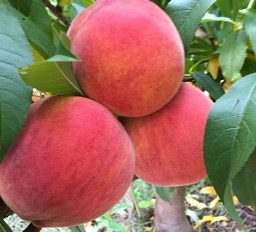Crop Production

A damaging soilborn fungus called Armillaria root rot (ARR) and the peach tree short life (PTSL) disease complex are currently the leading causes of peach tree mortality in Alabama. These diseases result in annual losses for the peach growers.
Estimated lifetime production losses attributed to Armillaria disease nationwide average more than $5 million annually. Guardian® is currently the dominant rootstock for the southeastern peach industry primarily due to its superior resistance to PTSL. However, Guardian® lacks resistance to ARR, which is now the leading cause of premature peach tree death in the southeast. ‘MP-29’ is a recently released clonal plum-peach interspecific hybrid rootstocks that provides superior resistance to ARR without the adverse effect on scion fruit size and productivity. Additionally, peach trees grafted on ‘MP-29’ are semi-dwarf, approximately 75% the size of those on Guardian®.
This reduction in vigor can help reduce management costs and provide a more desirable tree size for peach growers. ‘MP-29’s broad disease resistance can not only improve tree health, longevity and productivity, but can also help reduce chemical pesticide applications that would otherwise be required to suppress the disease problems in peach production. One other critical area in peach cultivation is the high cost and scarcity of labor. As a response to the labor issue, tree fruit industry has developed high-density orchard systems with smaller trees and a higher number of trees per acre, with all tree maintenance occurring from the ground using size-controlling rootstocks, such as ‘MP-29’.

Figure 1. ‘Bounty’ peach grafted on ‘MP-29’ rootstock, grown at the CREC, 2021.
Evaluating Rootstocks
Evaluating rootstock tolerances to biological, environmental, and edaphic stresses requires testing in local conditions. To compare peach rootstock tolerance to ARR, PTSL and evaluate the rootstock effect on tree size, phenological development, yield, and fruit quality, a site with a documented ARR history was selected at the Chilton Research and Extension Center near Clanton, Alabama. ‘Julyprince’ and ‘Bounty’ peach trees grafted on ‘MP-29’ and Guardian® rootstocks were planted in 2019 (Figure 1). Trees are trained to the conventional open center system at a planting distance of 16’ X 20’. Data to determine the effect of rootstock on tree survival rate, precocity, season of ripening, productivity, size control, anchorage, suckering, pest resistance, adaptability, and production efficiency are collected.
2021 results suggest both ‘Julyprince’ and ‘Bounty’ trees grafted on ‘MP-29’ were 38% smaller than trees on Guardian® (Table 1), based on data for tree trunk cross sectionl area (TCSA). Total yield per tree was similar for trees on both rootstocks (Table 1). Fruit size and flesh firmness were similar for ‘Bounty’ and ‘Julypince’ regardless of rootstock, while ‘Bounty’ trees on ‘MP-29’ produced sweeter fruit (Table 2, Figure 1).
Tabel 1. Rootstock Effect on 'Bounty' and 'Julyprince' TCSA and Yield, 2021
| Scion/Rootstock Cultivar | TCSA, cm2 | Yield, kg/tree |
|---|---|---|
| Bounty/Guardian | 93.5a | 17.4 |
| Bounty/MP-29 | 57.5c | 11.3 |
| Julyprince/Guardian | 77.4b | 14.9 |
| Julyprince/MP-29 | 47.7c | 14.2 |
Table 2. Rootstock Effect on Fruit Quality of 'Bounty' and 'Julyprince' Peaches, 2021
| Scion/Rootstock Cultivar | Mean Fruit Weight, g | Brix, % | Firm. 1, kg/cm2 | Firm. 2, kg/cm2 |
|---|---|---|---|---|
| Bounty/Guardian | 279.3a | 11.7b | 2.6b | 2.6b |
| Bounty/MP-29 | 289.3a | 12.4a | 2.1b | 2.5b |
| Julyprince/Guardian | 247.9b | 12.4a | 3.0a | 3.0a |
| Julyprince/MP-29 | 238.0b | 12.0ab | 2.8a | 3.0a |
Research is Ongoing
Studies will continue to more completely evaluate the overall rootstock performance in ARR infected field sites. The outcomes can provide a management solution for improved economic and environmental sustainability of peach production in Alabama.
